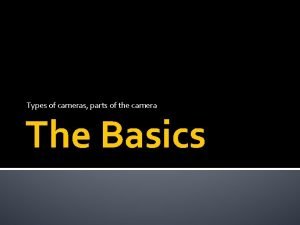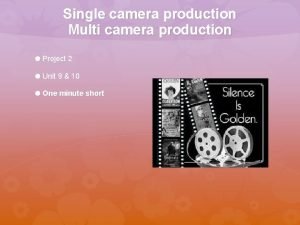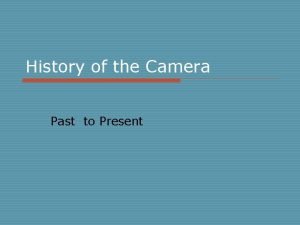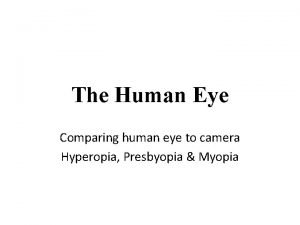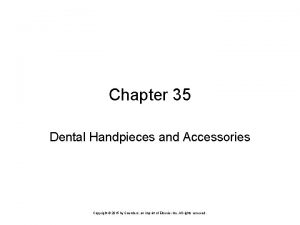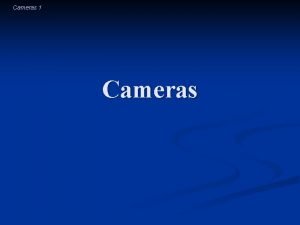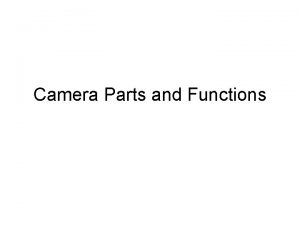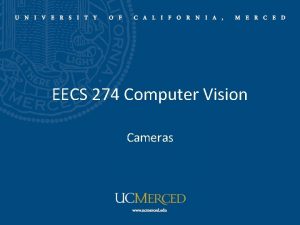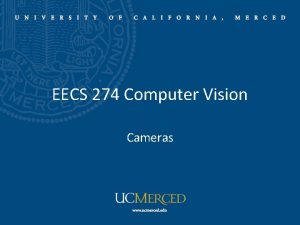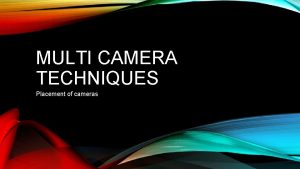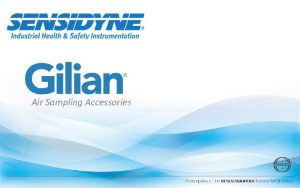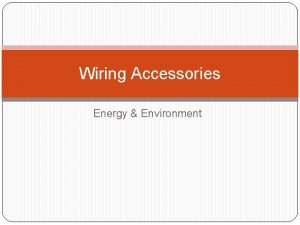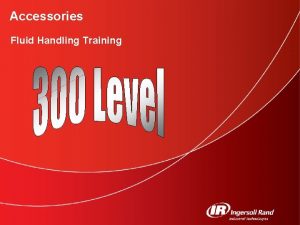CAMERAS PARTS of the CAMERA and ACCESSORIES TAKE












- Slides: 12

CAMERAS, PARTS of the CAMERA, and ACCESSORIES (TAKE NOTES ON THE UNDERLINED MATERIAL AND LABELLED DIAGRAMS)

TYPES OF CAMERAS Point and Shoot : inexpensive, simple to use, compact size, automatic settings SLR / DSLR - (Digital) Single Lens Reflex : often expensive, requires knowledge to use, total control of settings, interchangeable lenses, use of accessories Action / Specialty Cameras : Go. Pro, Polaroid, Underwater Camera

SINGLE LENS REFLEX • The light enters through the lens, reflects off of a mirror, and can be displayed in the viewfinder. • When a photo is taken, the mirror swings up, and the shutter opens, exposing the sensor. • The sensor then records the image, before the shutter and mirror close again.

PARTS OF A CAMERA 1. Lens 2. Body 3. Mirror 4. Shutter 5. Sensor 6. Viewfinder 7. Shutter Release 8. Hot Shoe 9. Mode Dial

TERMS & SETTINGS Megapixel : 1, 000 pixels Red Eye: the discoloration to the eyes of a person when flash is used White Balance : the color balance, based on your environments light, to make white a “true” white Exposure : the TOTAL amount of light received, determined by the following… ISO : sensitivity to light Aperture : measured in f/stop – affects the sharpness of your photo Shutter Speed : controls exposure, also controls motion

ISO Sensitivity to light. Affects the quality of the image. The higher the ISO, the more grain. Ideally, you have enough natural light to allow you to photograph at a low ISO setting. Remember that ISO works in tandem with Shutter Speed and Aperture to create a good image. (the images show pictures taken at 100, 400, 1600, and 3200 – with no aperture or shutter speed manipulation)

APERTURE Measured in f/stops Changes the Depth of Field in a photo. Depth of Field - the depth in a scene from foreground to background that will be sharp in a photo. Smaller apertures increase the depth of field, and larger ones decrease.

SHUTTER SPEED Controls exposure – lets light in Measured in time – fractions of a second. The shorter the length of time the shutter is open, the more crisp the image will be, but less light will enter. Controls how motion is photographed – the longer the shutter is open, the more light is recorded. Motion will be blurred, but likewise, darkness will be more visible.

SHOOTING MODES P – Program Mode - Pre-set settings, as a go to quick selection Portrait – camera automatically uses large aperture to take good portraits Av – Aperture Priority Mode – You select Aperture, the rest is auto Landscape - camera uses large depth of field to get everything in focus Tv – Shutter Priority Mode – You select Shutter Speed, the rest is auto Macro – allows focus on small subjects / get high detail Sports – camera uses fast shutter speed to capture fast moving objects clearly AUTO – All settings are automatically selected by camera M – Manual Mode – You select all settings

MEMORY CARDS SD Card – secure digital card – most commonly used memory device. Higher capacity cards can hold upwards of 2 TB Compact Flash – introduced in 1994, and is still used for higher end cameras, due to its fast data writing. Maximum capacity of 2 TB Memory Stick Pro (duo) – card used by Sony devices. While still used by some devices, SD cards are the standard. Maximum capacity of 2 TB x. D – card used by old Fujifilm and Olympus cameras Maximum capacity of 2 GB

ACCESSORIES Hot Shoe – the mounting point on top of the camera for accessories like a flash or microphone. Tripod Mount - the mounting point on the bottom of the camera for tripods, monopods, glidecams, etc.

LENSES There are TWO types of camera lenses ZOOM lenses have a range of focal length that they can view and photograph. PRIME or fixed lens is a lens that has a fixed position and cannot optically zoom. Within those two respective categories, specific use lenses exist. Some include: -Wide angle lens – for wider picture plane -Telephoto lens – used for sports and wildlife photography, to get a closer view from far away -Macro lens – used to focus closer on objects than other lenses can. Used for still life, small objects, plants, insects, etc.
 Parts of cameras
Parts of cameras Multi camera production examples
Multi camera production examples Single camera vs multi camera
Single camera vs multi camera Cameras in the past
Cameras in the past Speed detection of moving vehicle using speed cameras
Speed detection of moving vehicle using speed cameras Stem leaf plot
Stem leaf plot Image formation in camera
Image formation in camera Essential matrix
Essential matrix How to calculate half life physics
How to calculate half life physics Eye and camera parts and functions
Eye and camera parts and functions Transformer fitting
Transformer fitting Chapter 35 dental handpieces and accessories
Chapter 35 dental handpieces and accessories Chapter 35 dental handpieces and accessories
Chapter 35 dental handpieces and accessories
